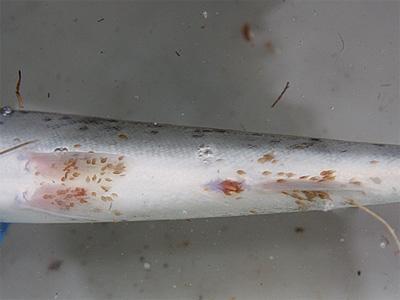You are here
Sea Lice ‘Out of Control’ at Loch Duart´s Salmon Farms

09/09/2013 Salmon and Trout Association, Scotland
Sea Lice ‘Out of Control’ in Many Scottish Regions
The underbelly of a wild juvenile sea trout, smothered in sea lice (the brown dots), eating away at its flesh. This fish was caught in June in Little Loch Broom within two miles of Wester Ross Fisheries’ salmon farm at Ardessie
Source: Salmon & Trout Association (Scotland)
Salmon farming industry figures reveal the Scottish regions where sea lice are out of control on fish farms.
As the damage being caused to wild salmon and sea trout in Scotland continues, the Salmon & Trout Association (Scotland) (S&TA(S)) has analysed aggregated sea lice data published by the Scottish Salmon Producers Organisation (SSPO), in its first two quarterly sea lice reports.
In June 2013 over one third of salmon farms (47 farms) on the Scottish mainland and in the Hebrides were in areas where average sea lice numbers exceeded the industry’s own limit for sea lice. In each of the previous five months at least one quarter (35 farms) were in this category.
In three key fish-farming areas, the SSPO’s ‘averaged data’ showed sea lice numbers in excess of the industry’s own limits for sea lice for every month from January to June 2013:
• ‘Inchard to Kirkaig North’ - eight active salmon farms, all run by Loch Duart Limited, the self-styled ‘sustainable salmon company’. Between February and April the average monthly lice count on Loch Duart farms was more than three times the industry’s own threshold and never went below twice that threshold in any month.
• ‘Kennart to Gruinard’ - seven farms operated by two companies, Wester Ross Fisheries Limited and Scottish Sea Farms Limited. Between February and June the average monthly lice count on farms in this area ranged between four to more than nine times the industry’s own threshold
• ‘Isle of Harris’ - 12 fish farms operated by three different companies including The Scottish Salmon Company and Marine Harvest (Scotland) Limited. Between February and June the average monthly lice count on farms in this area was at times more than five times the industry’s own threshold.
Hugh Campbell Adamson, Chairman of S&TA(S), said:
“The SSPO reports confirm that, in at least three key fish-farming regions of Scotland, sea lice numbers are out of control and consequently the fish farm companies are failing to protect wild fish from the devastating effects of the release of vast numbers of juvenile parasitic sea lice into west coast sea lochs.
We have a simple question for the SSPO. Why have companies such as Wester Ross Fisheries and Loch Duart not been expelled from SSPO membership when they fail so consistently and dramatically to keep sea lice numbers within the limits they have signed up to? If the SSPO’s Code of Good Practice on sea lice is to retain any credibility, then surely serial offenders like Wester Ross Fisheries and Loch Duart should be excluded from the salmon farmers’ trade organisation”.
Guy Linley-Adams, Solicitor to the S&TA(S) Aquaculture Campaign said:
“In light of the appalling sea lice numbers that companies such as Wester Ross Fisheries Limited and Loch Duart Limited have been reporting, we would ask Paul Wheelhouse MSP, Minister for the Environment in the Scottish Government, what he intends to do about this.
Specifically, when is the Minister going to introduce statutory controls on on-farm sea lice numbers to protect juvenile wild fish from picking up lethal infestations in the sea-lochs?
The SSPO’s reports also expose just how wrong Scottish Government was when it refused earlier this year, against the better advice of all west coast local authorities, all wild fish groups and its own Scottish Environment Protection Agency (see Note 7), to include a requirement in the Aquaculture and Fisheries Bill for all fish farms to publish weekly sea lice count data by law. The supposed confidential interests of the fish-farmers were allowed to trump the public right to know what is being released by the salmon farmers into the wider environment potentially causing huge damage to wild fish conservation.
However, the Scottish Government still has the power under the Aquaculture Act 2007 to order the publication of farm-specific data and we call upon them now to use that power”.
Why are sea lice on fish-farms such a threat to wild salmonids?
The negative impact of sea lice, produced in huge numbers by fish farms, on wild salmonids (salmon and sea trout) is widely accepted by fisheries scientists including the Scottish Government’s own Marine Scotland Science.
In Ireland, the Government of Ireland’s agency, Inland Fisheries Ireland, is crystal clear as to where the problem lies:
“The presence of salmon farms has been shown to significantly increase the level of sea lice infestation in sea trout in Ireland, Scotland and Norway. These lice infestations have been shown to follow the development of marine salmon aquaculture….studies from Ireland, Scotland and Norway have shown that in bays where salmon farming takes place the vast majority of sea lice originate from salmon farms……”
Most recently, a new paper published in 2013 by a group of fisheries experts from Norway, Canada and Scotland re-analyses data from various Irish studies and shows that the impact of sea lice on wild salmon causes a very high loss (34%) of those returning to Irish rivers.
Most importantly, there is clear evidence that both wild salmon and sea trout are in decline in Scotland’s ‘aquaculture zone’, whereas, generally, populations have stabilized on the east and north coasts where there is no fish-farming.
Copyright APES 2012 Website by Ionsign Online

